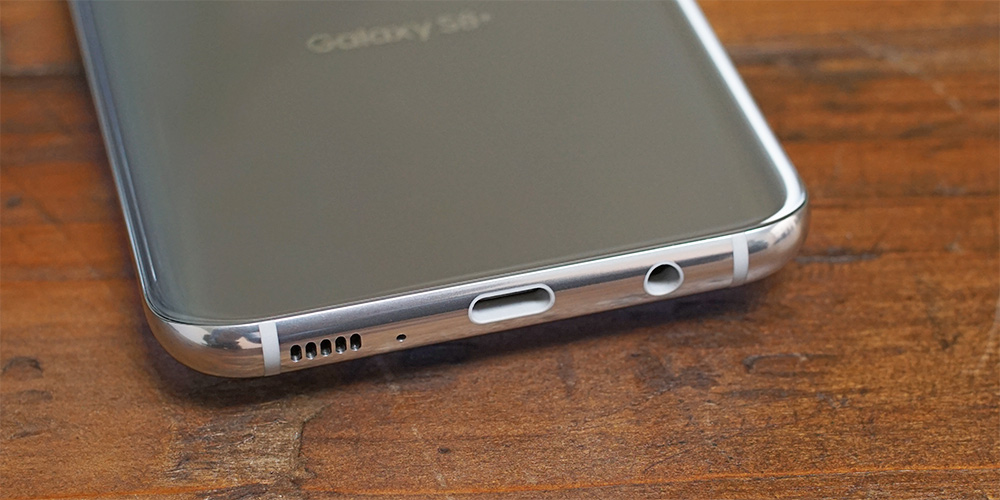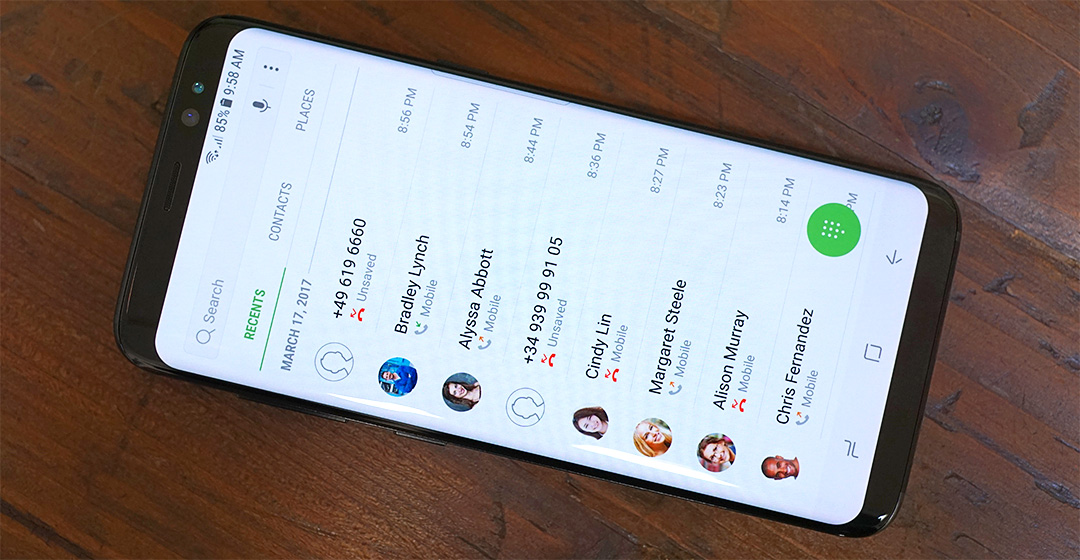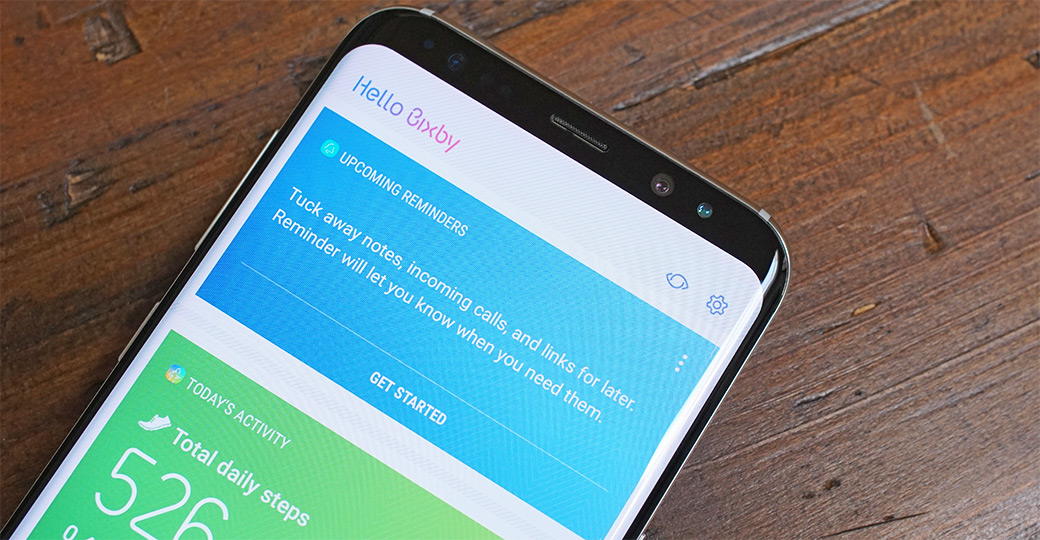Hands On With Samsung's Galaxy S8 and S8+: Taller Screens and Slimmer Bezels
by Matt Humrick on March 29, 2017 11:00 AM EST- Posted in
- Smartphones
- Samsung
- Galaxy
- Mobile
- Galaxy S8

Samsung officially unveiled the latest Galaxy devices at its Unpacked event in New York today. Previous Galaxy phones were part Porsche 911 Carrera, with an easily recognizable curvaceous style, and part Swiss Army knife, bristling with technology and features. This analogy holds true for the 5.8-inch Galaxy S8 and 6.2-inch Galaxy S8+, which share the same design DNA as the previous two generations.
The new phones’ aluminum frame remains sandwiched between edge-to-edge Corning Gorilla Glass 5, with curved sides on the front and back. The curved rear glass makes the phones easier to pick up and more comfortable to hold just as they did for the S7 and S7 edge, while the curved front glass—now standard on both S8 models—adds some visual flair.
There’s not much difference between the S8 and S7 along the sides either. The USB Type-C port on the bottom is flanked by a 3.5mm headphone jack and a single downward-firing speaker. The microSD/NanoSIM combo tray still resides on the top, and the thin power button is still a bit more than halfway up the right side. The only differences between new and old lie on the left side, where the volume buttons have been combined into a single rocker and a dedicated button for launching Samsung’s Bixby assistant makes its debut. Unlike the power button, I found myself occasionally pressing the Bixby button accidentally when picking up the smaller S8.
The most significant change is found up front, however, and it’s one that impacts both form and function. The Galaxy S8 and S8+ adopt Samsung’s new “Infinity Display” that stretches the screen vertically but not horizontally, deviating from the traditional 16:9 aspect ratio. The result is a QHD+ SAMOLED display with a 2960x1440 resolution and an 18.5:9 aspect ratio that’s very similar to the 18:9 aspect ratio display LG is using in its G6. Both Samsung and LG cite market research for this new display direction: People want larger screens that can show more content, but they also want phones that are useable with one hand and can fit in their pocket. The taller screen fits more content, so less scrolling, but keeps the phone narrow, so it’s easier to wrap your hand around.
Both S8 phones incorporate another emerging design trend: rounded display corners. Where LG’s G6 is using an LCD panel that actually has rounded corners, it appears Samsung is using a rounded bezel to cover the S8’s still sharp-cornered display. This avoids the aliasing that’s evident in the G6’s corners, producing a much smoother, nicer looking effect. While my time with the S8 was limited, it appears that TouchWiz and Samsung’s apps were redesigned to account for the rounded corners: Backgrounds extend the full height of the display and visual elements are still displayed along the top and bottom edges without getting cut off. Third-party apps, however, find their vertical dimensions constrained to the purely rectangular portion of the display, with the status bar above and the navigation bar below taking on black backgrounds.
The S8 and S8+ are also the first phones to receive the UHD Alliance’s Mobile HDR Premium certification that ensures a mobile device meets the minimum requirements for playback of 4K HDR video. This means that both S8s are capable of rendering at least 90% of the DCI-P3 color gamut, have a dynamic range of at least 0.0005-540 nits, and support a 10-bit display pipeline.
To keep the overall size of the phones in check, the S8/S8+ and G6 have dramatically reduced the bezel area around the taller screens. Samsung claims a screen-to-body ratio of 83% for its new Galaxy phones, less than the 91.3% of Xiaomi’s Mi MIX concept phone, but impressive nonetheless, especially considering how much hardware is located in the S8’s upper bezel. Besides the usual earpiece and proximity/ambient light sensors, there’s a new 8MP front-facing camera with f/1.7 lens and Smart AF that uses facial recognition for accurate focusing when taking selfies. There’s also an IR LED and IR camera for the iris-scanning security feature that made its debut on the ill-fated Galaxy Note7.
Shrinking the size of the lower bezel required relocating the fingerprint sensor to the back. Instead of placing it below the rear camera like we see on most other phones, Samsung places it next to the flush-mounted camera, which is less than ideal. Both the camera and the sensor are surrounded by a raised lip and are similar in size, making it difficult to locate the sensor by feel, and if your finger misses the sensor, you end up with a nice fingerprint on the camera lens. On the smaller S8, this issue may be mitigated with practice, but the problem is worse for the S8+. Being taller, it places the camera and sensor further from the lower edge, making it very difficult, if not impossible, to reach the sensor when holding the phone with a natural grip. Even with my larger-than-average hands, I struggled to reach the sensor without shifting my grip. I suspect people will turn to the iris scanner or the new face unlock feature, which uses the front camera for facial recognition after pressing the power button, to overcome the poor fingerprint sensor placement. The physical home button and capacitive navigation buttons, iconic Galaxy design features, have also been evicted in favor of the slimmer bezel, replaced by onscreen controls.



















208 Comments
View All Comments
melgross - Wednesday, March 29, 2017 - link
No, not pretty much everyone, some. Replaceable batteries means smaller batteries, and there's simply no way to have any real water resistance with a replaceable battery. Forget it.ddriver - Wednesday, March 29, 2017 - link
No it doesn't and yes there is.UglyFrank - Wednesday, March 29, 2017 - link
The S5/S4 Active/S5 Active/S5 Neo/S5 Mini all had water resistance with removable back covers. Granted it was IP67 but it was still good.halcyon - Wednesday, March 29, 2017 - link
LG G5 was waterproof enough for anything except constant diving use and had a replaceable battery. Nano-coating goes a long way:http://www.youtube.com/watch?v=dqXJHn-Us9U
rpmrush - Thursday, March 30, 2017 - link
Could you contradict yourself anymore? If it's not a fashion accessory to you, STOP YOUR WHINING ABOUT SYMMETRY. I believe we've all found the real tool.UglyFrank - Wednesday, March 29, 2017 - link
I'm not sure why you've had to replace the battery several times? I've had mine since 2014 and it is still capable of similar endurance to when I first got it. It even surprises me on occasion (e.g. the rare days where I get 6hrs SOT)halcyon - Wednesday, March 29, 2017 - link
Depends on what kind of battery you get. My note3 1st battery sucked really fast. 2nd has gone 2+ years and tons of recharge cycles.Not all batteries fall within the standard variation band. Of course you can always complain, and then they take your phone, wipe all your data, remove your screen protector and make you wait 4 weeks for the repairs (happened with my samsung).
ddriver - Wednesday, March 29, 2017 - link
That's highly doubtful, even if your phone spent 99.99% sleeping.There are other reasons to want a replaceable battery aside from replacing the stock one when it craps out. You could get a "recharge in a minute" - have a spare charged battery or two with you, very useful if you have a long day out or are somewhere remote hiking. You could get an oversized battery with a custom back.
Besides, with the option of user replaceable battery your device can last that much longer, provided you don't break it. I bought my note 3 with 2 batteries, got another 3 recently at a bargain, they were phasing out old stock. Which means this phone will be usable for many years to come, which is a good thing since it is not like it is getting obsolete - it is perfectly capable of doing what it is supposed to. And I actually use it as a computer, I run DAQ, VPL and diagnostics software on it. Absolutely NOT looking forward to replacing it. The SD card slot is indispensable too, although I wish it was hot-pluggable.
Reflex - Wednesday, March 29, 2017 - link
If your battery is LiPo it's generally not going to lose a significant amount of charge capacity in the phone's usable lifetime. It's why there has been a move towards LiPo. I have several phones at this point that have not demonstrated significant battery life loss despite being years old, including my daily driver.negusp - Thursday, March 30, 2017 - link
Stop spreading misinformation. lipo and lion have generally insignificant differences in terms of charge and degradation.